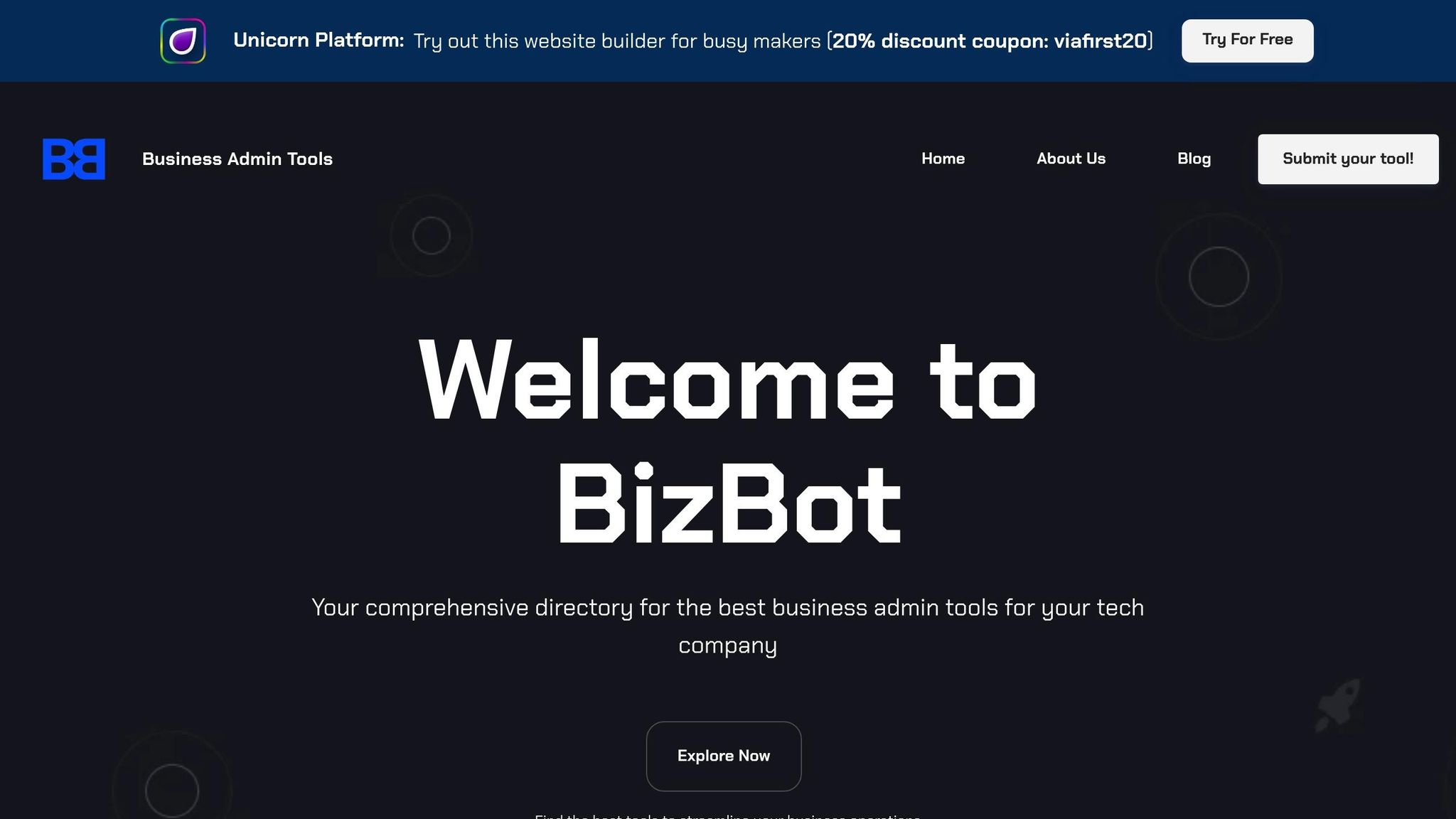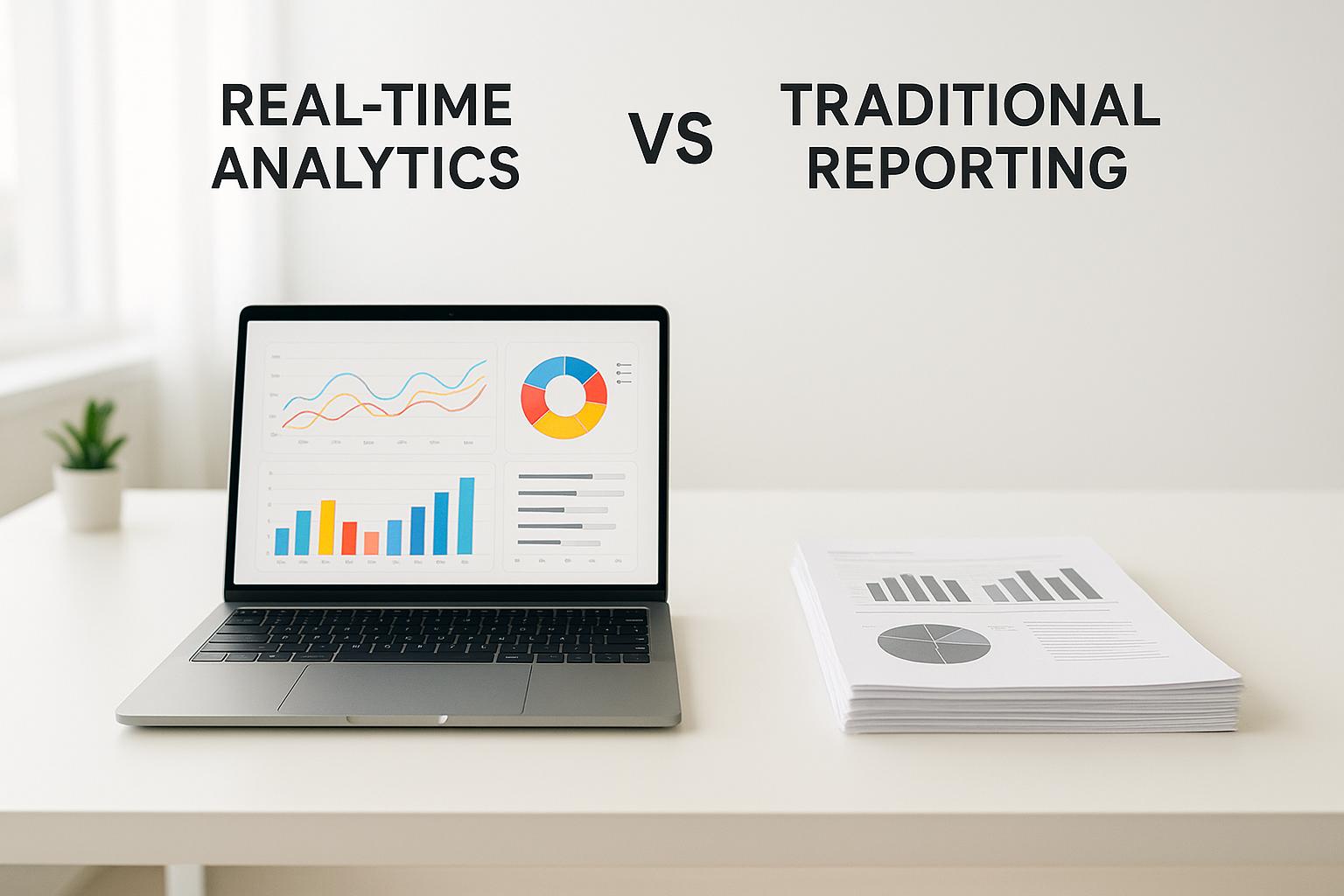AI personalization transforms how businesses interact with customers across multiple channels like websites, apps, stores, and social media. It ensures a connected, consistent experience by leveraging customer data and machine learning to predict preferences and deliver tailored interactions in real time. With 71% of consumers expecting personalized content, this approach is no longer optional for businesses aiming to meet modern customer expectations.
Key takeaways:
- Unified Data: AI consolidates data from various sources (web, mobile, in-store) to create detailed customer profiles.
- Machine Learning: Predicts behaviors, automates recommendations, and updates insights dynamically.
- Real-Time Actions: Delivers timely, relevant messages across all platforms, improving engagement and retention.
Benefits include higher conversion rates (up to 20%), increased customer retention (up to 30%), and improved lifetime value. However, challenges like data silos, integration complexity, and privacy compliance require careful planning and the right tools.
Top tools like Salesforce, Adobe Experience Platform, Braze, and LivePerson help businesses implement AI personalization effectively. Platforms like BizBot support smaller businesses by offering tools to streamline operations and manage costs.
AI personalization is reshaping customer engagement and driving growth for companies that adopt it.
AI’s Transformation of Omnichannel Personalization Has Only Just Begun: IAS’s Jim Egan
Key Components of AI-Powered Personalization Engines
AI-powered personalization engines rely on three main components to create seamless, omnichannel experiences. These elements work together to transform raw data into actionable insights, enabling businesses to connect meaningfully with customers at every touchpoint.
Customer Data Integration
At the heart of AI personalization lies customer data integration, which involves gathering, unifying, and managing data from various interaction points. This process creates detailed customer profiles that AI systems can analyze. Key data sources include transaction records, browsing habits, demographic details, social media activity, and real-time engagement metrics. Both structured data (like purchase history) and unstructured data (such as social media posts) are essential for building accurate profiles.
Technologies like Customer Data Platforms (CDPs), data lakes, API integrations, and cloud-based analytics tools make this integration possible. These tools consolidate data from multiple systems, ensuring AI engines have access to accurate and up-to-date information. For many U.S. businesses, breaking down data silos - where customer information is scattered across different platforms - remains a challenge. For instance, a customer’s website activity might be stored in one system, while their in-store purchases are tracked in another. Integration platforms solve this by creating unified profiles that update in real time, offering a complete view of customer behavior.
Privacy compliance is another critical factor. AI systems must adhere to regulations like the California Consumer Privacy Act (CCPA) and other federal privacy standards. This involves implementing robust encryption, anonymization, and transparent consent protocols tailored to U.S. legal requirements.
Machine Learning and Predictive Analytics
Machine learning is the engine that powers personalization. By analyzing integrated customer data, these algorithms identify patterns, segment audiences, and predict future behaviors. Unlike traditional demographic segmentation, machine learning creates dynamic groups based on real-time actions and preferences. Predictive analytics takes it a step further by automating recommendations and anticipating customer needs, with predictions constantly updated as new interactions occur.
Retailers often use these systems to stay one step ahead of their customers. For example, machine learning can detect when a customer is likely to make a purchase, abandon their cart, or require assistance, triggering automated responses. Intent detection is particularly powerful, allowing businesses to respond proactively to customer needs.
Real-Time Orchestration
Real-time orchestration turns insights into immediate, channel-specific actions. Whether it’s a personalized email, a push notification, or an in-app message, these systems ensure that each interaction is timely and relevant while maintaining consistent branding.
Retailers benefit from real-time dashboards that allow them to adjust ad spending and content based on live engagement data. For example, if interest in a specific product category spikes, the system can automatically increase related advertising and update inventory recommendations. Cutting-edge advancements like agentic AI - autonomous agents that guide customers through their journeys - are redefining how businesses interact with users. These systems adapt dynamically, timing communications based on factors like device usage or the time of day when customers are most active. This level of coordination is essential for implementing AI personalization across omnichannel strategies.
| Component | Function | Key Technologies | Business Impact |
|---|---|---|---|
| Customer Data Integration | Unifies data from all touchpoints | CDPs, APIs, Cloud Analytics | Builds complete customer profiles |
| Machine Learning & Predictive Analytics | Predicts behavior and automates recommendations | Predictive models, Intent detection | Boosts conversion rates by 10–15% |
| Real-Time Orchestration | Delivers timely, channel-specific experiences | Journey automation, Agentic AI | Improves customer retention by up to 30% |
When businesses integrate these three components, they can achieve measurable results, such as a 10–15% improvement in conversion rates and up to a 30% increase in customer retention.
For companies aiming to streamline operations while implementing AI-driven personalization, platforms like BizBot provide a directory of business tools that integrate with these engines. BizBot’s solutions are helping businesses automate omnichannel strategies while managing essential functions more efficiently.
How to Implement AI Personalization in Omnichannel Strategies
Bringing AI personalization into your omnichannel strategy requires a structured, data-driven plan that connects customer experiences across platforms while driving engagement.
Assessing Data Readiness
Before diving into AI personalization, it's crucial to evaluate your customer data. This means auditing sources like transaction records, website analytics, mobile app interactions, email metrics, social media activity, and customer service logs. The goal? Spot gaps, ensure data quality, and confirm accessibility across all platforms.
Start by cleaning and standardizing your data. AI systems rely on structured, high-quality information to function effectively. Often, critical data is trapped in isolated systems that don’t communicate. For example, having purchase history but lacking demographic details limits the AI’s ability to create accurate customer segments.
Don’t overlook privacy regulations like the California Consumer Privacy Act (CCPA). Implement clear consent mechanisms, transparent data usage policies, and processes that let customers access or delete their information. Regular audits and staff training on privacy laws are essential. Tools that automate compliance checks and maintain audit trails can also help minimize legal risks.
Once your data is verified and consolidated, you’re ready to leverage AI for dynamic customer segmentation.
Creating AI-Driven Customer Segments
AI takes customer segmentation to the next level by moving beyond static demographic categories to dynamic, behavior-based groupings. Inputs like age, location, and income are combined with behavioral data - think website visits, purchase history, and engagement trends. Predictive analytics adds even more depth, forecasting behaviors like purchase likelihood or churn risk.
AI algorithms analyze this data to uncover patterns, grouping customers based on shared traits and behaviors. These AI-driven segments are constantly updated, adapting to real-time customer actions. For example, the system might identify customers who prefer SMS promotions over email or flag individuals who repeatedly browse specific product categories without making a purchase.
As preferences shift and new data rolls in, these AI models adjust, ensuring your personalization efforts stay relevant and impactful.
Once your customer segments are well-defined, the next step is integrating them across channels for a seamless experience.
Integrating Channels and Automating Workflows
The final step is connecting all digital and physical touchpoints to ensure consistent customer experiences. Start by unifying customer profiles across platforms, synchronizing data in real time, and using AI to deliver consistent messages and offers no matter the channel.
For instance, if a customer browses products online, that information should be immediately accessible to in-store associates. Similarly, an in-store purchase could trigger personalized follow-up emails or app notifications.
AI-powered marketing automation tools can handle these tasks seamlessly. They can send follow-up emails after cart abandonment, push notifications for in-store events, or even adjust website content dynamically based on user behavior.
To make this work, integrate your CRM, point-of-sale systems, and digital marketing platforms. This synchronization ensures customer profiles are up-to-date and that personalized workflows run smoothly across all channels.
sbb-itb-d1a6c90
Benefits and Challenges of AI Personalization
This section dives into the upsides and hurdles businesses encounter when weaving AI personalization into their omnichannel strategies.
Advantages
AI personalization offers a range of benefits, starting with higher conversion rates. When customers receive tailored product recommendations and timely content, they’re more likely to make a purchase. In fact, research indicates that AI-powered personalization can boost conversion rates by as much as 20%. A prime example is Amazon's recommendation engine, which uses browsing and purchase history to suggest products - contributing significantly to their overall sales.
Another major win? Customer retention. By delivering seamless, personalized experiences across email, mobile apps, and in-store visits, AI helps businesses keep customers coming back. Companies report 5-10% increases in retention after implementing AI-driven personalization strategies.
Then there’s the financial upside. Personalization driven by AI increases customer lifetime value (CLV). Fast-growing companies leveraging these strategies generate up to 40% more revenue compared to slower-growing competitors. Businesses using AI-powered engagement tools see up to 30% higher CLV than those relying on traditional methods. This happens because AI anticipates customer needs, encourages repeat purchases, and builds stronger, long-term relationships.
AI also enhances operational efficiency by automating repetitive tasks. For example, it can cut customer service response times by up to 50% and reduce ticket backlogs. Retailers often rely on AI to send follow-up emails, push notifications, or retargeting ads to recover abandoned carts, freeing up staff to focus on more complex tasks.
Finally, AI offers scalability, delivering personalized experiences to a large audience without sacrificing quality. But while the benefits are clear, implementing AI personalization isn’t without its challenges.
Challenges
Despite its advantages, AI personalization comes with a set of obstacles. One of the biggest issues is data silos - when customer information is scattered across disconnected systems. To tackle this, businesses need centralized data platforms and APIs to integrate everything smoothly. Establishing strong data governance practices ensures consistency and accessibility across teams.
Integration complexity is another headache. Many companies struggle to deploy AI personalization across multiple channels due to outdated systems, incompatible data formats, and technical limitations. Underestimating the resources required to integrate legacy platforms only adds to the problem. Solutions include investing in middleware tools and selecting AI platforms with strong integration features. Standardizing data formats before rolling out AI systems can also help streamline the process.
Privacy concerns are growing as consumers become more conscious of how their data is used. While 71% of people expect personalized content, many are uneasy about data collection practices. Regulations like CCPA and GDPR add another layer of complexity, requiring businesses to navigate compliance carefully. To address these concerns, businesses should obtain clear customer consent, maintain transparency about how data is used, and anonymize information whenever possible. Regular audits of AI models can ensure fairness and accuracy. According to the IBM Institute for Business Value, three in five consumers are open to using AI tools while shopping, but only if they trust how their data is handled.
Another challenge is data quality. AI systems rely on clean, well-structured data to deliver accurate personalization. Poor data can lead to irrelevant recommendations, damaging customer relationships instead of strengthening them. To avoid this, businesses should prioritize data cleaning and standardization, implement ongoing quality checks, and establish clear protocols for data collection and maintenance.
For businesses looking to overcome these hurdles, platforms like BizBot provide tailored tools to support the infrastructure needed for effective omnichannel engagement strategies.
Tools and Resources for AI-Powered Personalization
To successfully implement AI-powered personalization in your omnichannel strategy, choosing the right tools is crucial. The market offers a variety of platforms tailored for customer data management, marketing automation, and real-time orchestration. These tools are designed to help US businesses deliver seamless experiences while adhering to local regulations.
BizBot: A Hub for Business Administration Tools

For US companies looking to streamline their operations, BizBot provides a one-stop directory for business administration tools. It includes curated resources for accounting, HR, legal services, and management - key areas that form the backbone of a strong omnichannel strategy.
One standout feature of BizBot is its subscription management tool. This tool helps businesses track and optimize software expenses, a critical need when managing multiple AI personalization platforms. By consolidating subscription tracking, companies can eliminate redundant tools, reduce unnecessary spending, and focus their budgets on the most effective solutions.
BizBot is particularly suited for freelancers, small businesses, and growing companies. Its user-friendly approach eliminates the need for extensive technical expertise, making it a practical option for smaller US businesses that may not have a dedicated IT team. From simple accounting solutions to digital CFO services, BizBot simplifies the search for tools that support a robust operational foundation.
Other AI Personalization Platforms
In addition to BizBot, there are several powerful AI personalization platforms available to enhance omnichannel engagement:
- Salesforce Marketing Cloud: Known for its advanced AI-driven segmentation and automation, this platform is ideal for managing complex customer journeys. It integrates seamlessly with existing US business systems, ensuring a smooth implementation process.
- Adobe Experience Platform: This platform focuses on real-time customer profiles and predictive analytics. It unifies data from web, mobile, email, and in-store interactions, enabling retailers to deliver consistent, personalized experiences across all touchpoints.
- Braze: Popular among media and finance companies, Braze excels in real-time orchestration. It processes customer behavior instantly, triggering precise, channel-specific messages - a valuable feature in fast-moving industries. For example, Netflix reported a 75% increase in user engagement from AI-driven recommendations, while Starbucks saw a 25% sales boost through personalized promotions.
- LivePerson: Specializing in conversational AI, LivePerson draws on one of the largest customer datasets to provide actionable insights. Its tools continuously improve AI-driven conversations, making it a strong choice for businesses prioritizing customer service.
When evaluating these platforms, US businesses should focus on features like data encryption, audit trails, consent management tools, and user access controls to ensure customer information is protected and regulatory requirements are met.
The financial benefits of selecting the right platform are clear. According to a Marketo study, companies using AI-powered personalization report an average 20% increase in sales and a 15% boost in customer retention rates. Moreover, businesses with strong omnichannel engagement strategies retain 89% of their customers, compared to just 33% for those without such strategies.
| Platform | Key Strengths | Best For | US Compliance |
|---|---|---|---|
| Salesforce Marketing Cloud | Advanced segmentation, automation | Complex customer journeys | CCPA, strong integration |
| Adobe Experience Platform | Real-time profiles, predictive analytics | Unified customer views | Full US compliance |
| Braze | Real-time orchestration | Fast-paced industries | Yes, with audit trails |
| LivePerson | Conversational AI, large dataset | Customer service focus | Comprehensive security |
Conclusion: The Future of AI Personalization
AI personalization is setting new standards for engaging customers across multiple channels, powered by tools like real-time orchestration and predictive analytics. The numbers speak for themselves: 70% of global organizations now leverage AI to enhance customer satisfaction. By scaling what once felt like the intimate service of a local shop, AI ensures every customer feels uniquely valued.
The next frontier is hyper-personalization - where AI transcends basic segmentation to create truly individualized experiences. Modern systems use a mix of browsing habits, purchase history, sentiment analysis, and real-time data to craft one-on-one interactions at every stage of the customer journey. With agentic AI, these systems can guide customers seamlessly, from initial awareness to long-term loyalty, constantly learning and improving along the way.
As hyper-personalization reshapes customer expectations, operational efficiency becomes a must. Platforms like BizBot simplify back-office tasks, allowing businesses to focus more on delivering tailored experiences. Features such as subscription management also help companies manage AI-related costs effectively, ensuring resources are used strategically.
The payoff is clear: companies that excel in AI personalization see revenue increases of up to 40%, while 67% of consumers now expect interactions tailored to their needs.
To stay ahead, businesses need unified data, real-time orchestration, and a strong operational framework. By integrating these elements and continuously refining systems based on performance insights, companies can not only meet but exceed growing customer expectations.
Looking forward, AI personalization will continue evolving - becoming more contextually aware and proactive. Organizations that invest in robust AI tools and build solid operational foundations today will be well-equipped to thrive in this increasingly personalized marketplace.
FAQs
What steps can businesses take to ensure data privacy compliance when using AI for personalized customer engagement?
To maintain compliance with data privacy regulations while using AI for personalization, businesses must prioritize adherence to laws like GDPR, CCPA, and other relevant policies. Begin by being upfront with customers - clearly explain how their data will be used and secure their consent before collecting any personal details.
Strengthen your defenses with data encryption and strict access controls to safeguard sensitive information. Conduct regular audits of your AI systems to ensure ethical and secure data processing. Wherever you can, anonymize or pseudonymize customer data to reduce potential risks.
Keeping up with changes in privacy regulations and being transparent about your data practices not only helps avoid legal issues but also fosters trust with your customers.
How can businesses address data silos and integration challenges to enhance AI-driven omnichannel engagement?
Breaking down data silos and tackling integration issues is key to making AI-driven omnichannel engagement work effectively. The first step? Bring all your data together in a single, unified platform. This ensures customer interactions from every channel are easily accessible, giving AI the ability to analyze and tailor experiences effortlessly.
To connect systems that don’t naturally work together, consider using APIs or middleware solutions. These tools help create a smooth flow of data between platforms. It’s also a good idea to routinely audit your data infrastructure to ensure your tools stay compatible and work efficiently. When these hurdles are addressed, businesses can tap into the true power of AI personalization and consistently deliver engaging, seamless experiences across every channel.
How does AI-driven personalization improve customer retention and lifetime value in omnichannel strategies?
AI-powered personalization is transforming how businesses engage with their customers, boosting retention and lifetime value by crafting experiences uniquely suited to each individual. By diving into customer data - think preferences, behaviors, and past interactions - AI can generate spot-on recommendations, offers, and messages that truly connect with users.
This kind of tailored approach strengthens the bond between businesses and their audience, driving higher satisfaction and loyalty. Plus, when engagement feels consistent across all channels - whether it's online, in-store, or through a mobile app - customers are more likely to feel appreciated. The result? More repeat purchases and relationships that stand the test of time.


